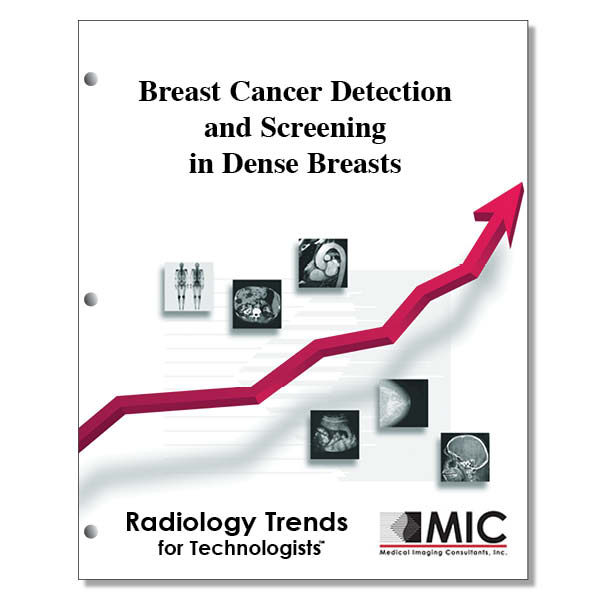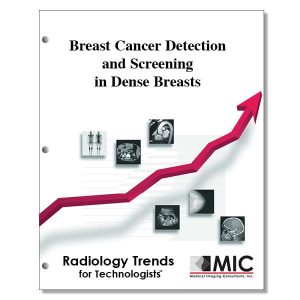

Breast Cancer Detection and Screening in Dense Breasts
Understanding that mammographically dense breast tissue is associated with higher breast cancer incidence and mortality, this course focuses on density assessment, breast cancer risk, current legislation, and changing guidelines for supplemental screening.
Course ID: Q00794 Category: Radiology Trends for Technologists Modalities: Breast Sonography, Mammography, MRI, RRA2.75 |
Satisfaction Guarantee |
$29.00
- Targeted CE
- Outline
- Objectives
Targeted CE per ARRT’s Discipline, Category, and Subcategory classification:
[Note: Discipline-specific Targeted CE credits may be less than the total Category A credits approved for this course.]
Breast Sonography: 1.50
Patient Care: 0.75
Patient Interactions and Management: 0.75
Procedures: 0.75
Anatomy and Physiology: 0.75
Mammography: 2.50
Patient Care: 0.50
Patient Interactions and Management: 0.50
Procedures: 2.00
Anatomy, Physiology, and Pathology: 1.50
Mammographic Positioning, Special Needs, and Imaging Procedures: 0.50
Magnetic Resonance Imaging: 0.50
Procedures: 0.50
Body: 0.50
Registered Radiologist Assistant: 2.50
Procedures: 2.50
Thoracic Section: 2.50
Sonography: 0.50
Procedures: 0.50
Superficial Structures and Other Sonographic Procedures: 0.50
Radiation Therapy: 1.50
Patient Care: 1.50
Patient and Medical Record Management: 1.50
Outline
- Introduction
- Strengths and Limitations
- Mammographic Findings
- Strengths and Limitations
- US Findings
- ABUS Findings
- Strengths and Limitations
- CEM Findings
- Strengths and Limitations
- MRI Findings
- MR Imaging
- Contrast-Enhanced Mammography
Objectives
Upon completion of this course, students will:
- understand the association of dense breast tissue with breast cancer incidence and mortality rate
- recall the decrease in breast cancer deaths since 1989
- state the screening modality proven to reduce breast cancer deaths
- discuss the glandular and fat elements of dense breasts
- list the four categories of BI-RADS breast density
- relate the percentage of dense breasts in women aged 40 years and older
- list factors that can increase breast density
- know which BI-RADS edition stipulates a subjective assessment of breast density
- explain inter-reader and intra-reader mammography variability
- know the strongest independent risk factors for developing breast cancer aside from age and genetics
- recall the breast cancer risk for patients with extremely dense breasts as compared to the risk for patients with fatty breast
- define interval cancer
- know how many more times likely it is for interval cancers to develop in dense breasts
- differentiate between breast density studies
- know the sensitivity of mammography as it applies to increasing breast density
- explain the mortality rate benefit of screening mammography
- recall the year that breast density legislation began
- know which state was first to mandate coverage for supplemental screening and that patients be sent letters to inform them about breast density after they undergo mammography
- state the year that the U.S. Congress passed a national breast density reporting law
- name the month and year the U.S. FDA finalized language for mammography centers to inform women about dense breasts
- recite the year in which the Find It Early Act was introduced
- interpret data in order to understand participant eligibility criteria
- list the benefits of digital breast tomosynthesis
- state the mean interpretation time for mammography with digital breast tomosynthesis as compared to full field digital mammography
- choose the plane in which digital spot compression views can be taken in order to assist with identifying spiculations
- differentiate between blind spots, forbidden zones, and no-man’s land on mammograms
- note where the no-man’s land of the breast can be found
- explain the types of cancers that can be identified when using supplemental screening ultrasound in patients with dense breasts
- state the positive predictive value of handheld ultrasound
- state the ACR false-positive benchmark for mammography
- list the advantages of automated breast ultrasound over handheld ultrasound
- recall what percent of breast cancers are occult at US and mammography
- list the specific disadvantages of handheld ultrasound
- list the limitations for automated breast ultrasound
- indicate the features seen with malignant non-mass lesions seen at ultrasound
- define which anatomic plane specific to automated breast ultrasound shows the breast as it would appear on the operating table
- choose the year in which contrast enhanced mammography was approved by the U.S. Food and Drug Administration for diagnostic purposes
- list the main disadvantages of contrast enhanced mammography
- list the most common benign lesions that may enhance on contrast enhanced mammography
